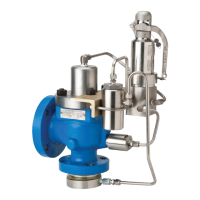
Do you have a question about the Anderson Greenwood Series and is the answer not in the manual?
| Brand | Anderson Greenwood |
|---|---|
| Orifice Size | D to T |
| Series | Series 90 |
| Category | Pressure Relief Valves |
| Set Pressure Range | 6000 psig |
| Pressure Range | Up to 6000 psig |
| Materials | Stainless Steel, Carbon Steel, Alloy Steel |
| Connection Type | Flanged, Threaded |
| Certifications | ASME, PED |
| Standards | API 526 |
Explains the modulating action and differential areas principle for valve operation.
Covers flange installation, drain fittings, insulation, and remote sense line requirements.
Details the procedure for starting up the valve, including block valve operation and slow opening.
Introduces recommended maintenance procedures for pilot and main valves, emphasizing regular programs.
Provides step-by-step instructions for disassembling the main valve, listing parts to remove and inspect.
Details how to recondition valve seats through lapping, emphasizing flatness and compound use.
Provides instructions for assembling the main valve, including part installation and lubrication.
Provides detailed steps for disassembling the pilot valve, including part identification and removal.
Covers pilot assembly, lapping seat/nozzle, cleaning, sub-assembly, and lift lever installation.
Covers maintenance for condensate traps, check valves, and field test devices, including seal replacement.
Instructions for reassembling the pilot to the bracket and connecting tubing for the valve.
Defines key terms related to pilot pressure adjustment, such as set pressure and cracking pressure.
Describes the procedure for pre-setting and checking pilot set pressure using a test setup.
Specifies the allowable adjustment range for pilot set pressure and when to consult the factory for spring changes.
Lists performance requirements for the pilot, including crack pressure and set pressure tolerance.
Outlines general requirements for testing the complete valve assembly, specifying steam as the test medium.
Details the procedure for checking the set pressure of the valve assembly by slowly increasing inlet pressure.
Explains how to perform leakage checks on the valve seats and external joints at specified pressures.
Describes the procedure for performing a back pressure test on the secondary zone of the valve.
Provides guidance on set pressure adjustment, blowdown, and minimum required lift for valve performance.
Introduces checking set pressure with the valve installed in service using a field test accessory.
Provides step-by-step instructions for conducting the pilot set pressure field test using a test setup.
Lists the part number for the pilot repair kit.
Provides a table of part numbers for main valve repair kits based on orifice size and flange rating.
